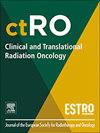Effect of FLASH proton therapy on primary bronchial epithelial cell organoids
IF 2.7
3区 医学
Q3 ONCOLOGY
引用次数: 0
Abstract
Purpose
The effects of conventional (CONV) and FLASH proton therapy on primary bronchial epithelial cell (PBEC) organoids from individuals with chronic obstructive pulmonary disease (COPD) were investigated. The primary objective was to compare the effect of FLASH and CONV on COPD PBEC organoids with a focus on DNA damage, organoid formation, and gene expression.
Methods
PBECs were obtained from six COPD donors, cultured as three-dimensional (3D) organoids and exposed to 2 and 8 Gy CONV and FLASH proton radiation at the Holland Proton Therapy Center. DNA damage was assessed by γH2AX staining. Organoid formation capacity was assessed by counting the organoids formed after reseeding irradiated cells at 24 h and 7 days. Bulk RNA sequencing (RNAseq) and qPCR analyses were performed to identify pathways and differences in the radiation response.
Results
γH2AX foci analysis showed a significant dose-dependent increase in DNA damage at 1 h for both CONV and FLASH treatments, without differences between the two modalities. Organoid formation assays revealed a dose-dependent decrease in organoid formation capacity at 24 h for both treatments. At 7 days, 2 Gy FLASH-treated samples showed significantly reduced organoid formation compared to 2 Gy CONV (p = 0.008). RNAseq identified CONV and FLASH-induced changes in expression of DNA-damage response and apoptosis pathway genes. A dose-dependent upregulation of MDM2, GDF15, DDB2, BAX, P21, AEN and a decrease in MKi67 expression was confirmed by qPCR analysis.
Conclusion
No significant differences were found in DNA damage or gene expression profiles between CONV and FLASH. The organoid formation assay showed a prolonged detrimental effect in the FLASH-treated organoids, suggesting a more complex interaction of FLASH with lung epithelial cells. The results of this study contribute to the advancement of robust in vitro human lung models for investigating the mechanisms of action of FLASH, potentially facilitating the treatment of NSCLC patients with proton FLASH therapy.
FLASH质子治疗对原代支气管上皮细胞类器官的影响
目的探讨常规(CONV)和FLASH质子治疗对慢性阻塞性肺疾病(COPD)患者原发性支气管上皮细胞(PBEC)类器官的影响。主要目的是比较FLASH和CONV对COPD PBEC类器官的影响,重点是DNA损伤、类器官形成和基因表达。方法从6名COPD供者中获得spbecs,在荷兰质子治疗中心培养成三维(3D)类器官,并暴露于2和8 Gy的CONV和FLASH质子辐射下。γ - h2ax染色检测DNA损伤。通过计算辐照细胞在24 h和7 d后形成的类器官来评估类器官的形成能力。我们进行了大量RNA测序(RNAseq)和qPCR分析,以确定辐射反应的途径和差异。结果γ - h2ax焦点分析显示,CONV和FLASH治疗1 h时DNA损伤均呈剂量依赖性增加,两种治疗方式之间无差异。类器官形成试验显示,两种处理在24 h时类器官形成能力均呈剂量依赖性下降。在第7天,2 Gy flash处理的样品与2 Gy CONV相比,类器官形成明显减少(p = 0.008)。RNAseq鉴定出CONV和flash诱导的dna损伤反应和凋亡通路基因的表达变化。qPCR分析证实MDM2、GDF15、DDB2、BAX、P21、AEN的表达呈剂量依赖性上调,MKi67的表达降低。结论CONV与FLASH在DNA损伤及基因表达谱上无显著差异。类器官形成实验显示,FLASH处理的类器官具有长期的有害影响,这表明FLASH与肺上皮细胞的相互作用更为复杂。本研究的结果促进了强大的体外人肺模型的发展,用于研究FLASH的作用机制,有可能促进质子FLASH治疗非小细胞肺癌患者。
本文章由计算机程序翻译,如有差异,请以英文原文为准。
求助全文
约1分钟内获得全文
求助全文
来源期刊

Clinical and Translational Radiation Oncology
Medicine-Radiology, Nuclear Medicine and Imaging
CiteScore
5.30
自引率
3.20%
发文量
114
审稿时长
40 days
 求助内容:
求助内容: 应助结果提醒方式:
应助结果提醒方式:


